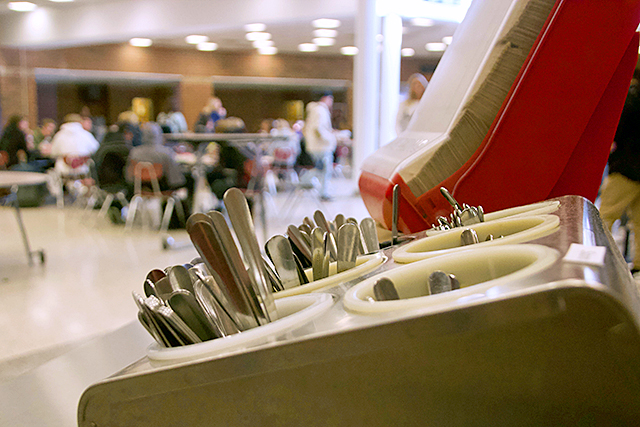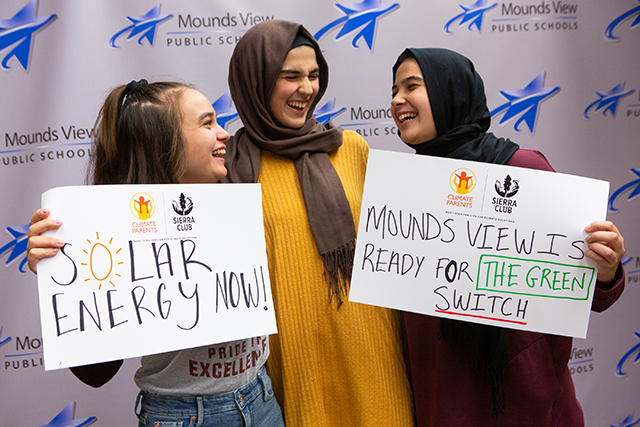Students at Stillwater Area High School began adjusting to a small — yet significant — change at the start of the new year: no more plastic forks and spoons.
Single-use plastic utensils have been replaced with metal flatware in the school lunchroom.
Julia Bennett, 17, and Isabella Schaak, 18, both seniors at Stillwater, had set out on a mission to eliminate the use of single-use plastics in their school’s lunchroom. The initiative grew out of an open-ended final project prompt in their AP government class.
“Climate change is really coming into effect and it’s going to affect our generation the most, and future generations,” said Schaak, listing the wildfires in Australia as a current example.
Through social media, she follows MN Youth Climate Strikes, a youth-led group that coordinates climate strikes across the state, including sit-ins at the Capitol to demand action from state leaders. But, for her and Bennett, taking action at the school level felt like the natural place to start.
“We were thinking of something local where we could make a change — because that’s important to us — and we decided to start here,” Bennett said.
It’s a sentiment shared among their peers in other school districts as well. From eliminating single-use plastic items to pressing school boards to commit to 100 percent clean energy, Minnesota students are changing how schools respond to climate change.
Jason Rodney, a youth program coordinator for Climate Generation — a Minneapolis-based nonprofit founded by Will Steger in 2006 that’s focused on supporting climate change education and youth-led climate change solutions — says he supports students who are involved in projects at the school or city level.
“With such a daunting movement to be part of or a problem to face as climate change, it just helps to have a bigger picture, a community,” he says.
His organization is one of many that are helping youth think about how to take action against climate change, through policy changes at both the state and local levels. In schools, he says some of the other most common initiatives include things like integrating climate change education into classrooms, providing more training and job opportunities in green careers — like sustainable agriculture practices, especially in rural districts — and improving composting and recycling services at schools.
Reducing waste in lunchrooms
In advance of the board meeting that Bennett spoke at earlier this month, they launched an online petition and collected more than 300 signatures supporting their ask.
It ended up being an easy sell, since district staff had already been looking into switching to real flatware at the high school — the only school site still using plastic forks and spoons.
It’s something students have advocated for years, says Kelley Linquist, nutrition services supervisor for Stillwater Area Public Schools. But the push from Bennett and Schaak “definitely spurred us to go into action quicker.”
The holdup at the high school largely came down to staffing shortages, she says. Converting from plastic eating utensils to metal flatware means adding a few more steps to the washing line. It needs to get sorted and run through the dishwasher twice.

[image_credit]MinnPost photo by Erin Hinrichs[/image_credit][image_caption]District staff had already been looking into switching to real flatware at the high school — the only school site still using plastic forks and spoons.[/image_caption]
Even after factoring in replacement costs, she says, the conversion will save the school money. And it builds upon a few prior efforts to make the lunchroom more environmentally friendly, including the purchase of a more energy-efficient dishwasher, swapping out condiment cups with pumps and collecting food scraps for pig feed on local farms.
Encouraged by the switch away from plastic utensils, Bennett and Schaak are already thinking of next steps — like converting from pre-made salads in plastic containers to a salad bar or installing hand dryers in the bathrooms to cut down on paper towel consumption.
At St. Louis Park High School, Zoe Frank, 17, says students have been working on a campaign to better label recycling bins — a change that’ll go into effect soon.
“Some rooms have a gray recycle and a blue trash. In the next room, it’ll be the opposite,” she says.
To track how impactful such a simple change can be, Frank, along with about a dozen of her peers who are on the Roots and Shoots club at her school, plan to spend some Friday afternoons tallying up the number of recycled items over the next few months.
Looking to take conservation efforts a step further, she says they’d also like to see the school do away with plastic water bottles.
“I think it’s really important to a lot of people because you hear it over and over again: It’s going to be this generation that has to deal with the consequences of climate change,” she said. “And I think it awakens anxiety in a lot of people.”
Converting to clean energy
The Roots and Shoots club works closely with the city’s environment and sustainability commission, Frank says, noting she currently sits on the commission as a student representative.
This relationship helped spur the city to adopt a climate action plan in February 2018, with the St. Louis Park Public Schools district following suit by passing a climate leadership resolution in June of the following year.
The resolution lays out five big goals, including a commitment to net zero greenhouse gas emissions by 2040 and 100 percent renewable electricity from renewable sources like wind and solar.
Operating under a more aggressive timeline, the Mounds View Public Schools board adopted a student-driven clean energy resolution this past fall, committing to a goal of “achieving 100 percent clean electricity by 2030.”
Two students who lead an environmental club at Irondale High School — Lily Cartier, 17, and Sabrina Deriche, 16 — helped spearhead the initiative. With the backing of two science teachers, they and other club members connected with the Sierra Club for added guidance and support. Their efforts fell flat the first time the board considered the resolution. But they kept at it over the summer and got the commitment to addressing climate change that they were seeking the second time around.

[image_credit]Courtesy photo[/image_credit][image_caption]Lily Cartier, Iman Deriche and Sabrina Deriche celebrating the passage of a clean energy resolution they'd advocated for at a Mounds View Public Schools board meeting this past fall.[/image_caption]
The resolution would support and potentially extend the district’s existing rooftop solar installations, a commitment anticipated to save the district nearly $1 million in electricity costs over the next 25 years.
Now Deriche and Cartier are focused on holding the district accountable. That includes sustaining momentum as the makeup of the board changes, as it did this past fall.
“I already emailed all of the new members to remind them,” Deriche said. “I’ve gotten their vocal support for it.”






Looks like the kids are going to be okay. (Or at least have a shot, assuming the adults haven’t messed things up irrevocably).